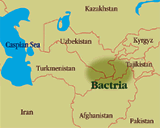 |
|
 |
| 1 |
Vase with Divine Figures |
| |
3rd millenium
The figures kneeling on the bulls and leopards and grasping
snakes and bulls on this vase appear to be weather gods, important
in agrarian societies.
|
|
|
 |
| 2 |
Seated Statue of a Goddess |
| |
Late 3rd—early2nd millennium
B.C.
This graceful female
figure—sporting a short haircut and wearing a dress beautifully
decorated with flowering plants—appears to have been worshipped
as an earth goddess. |
|
| 3 |
Weight in the Form of a Standing
Bull |
| |
Late 3rd—early2nd millennium
B.C.
This weight in the shape
of a bull weighs the same as an early unit of measurement. Such
devices were crucial for trade, however, this charming weight
is also a sculptural achievement. |
|
| |
 |
| 4 |
Worshiper |
| |
Mid—2nd millennium
B.C.
The pliant lines and delicate details of this Minoan man,
worshipping a sky god, embody Mediterranean aesthetics. |
|
|
| About four thousand years ago, the ancient
Greeks began to settle in the areas north and eastward of the Mediterranean
Sea that prospered as the crossroad between the Orient and the Mediterranean,
and in time, gave rise to Hellenistic civilization. In the 4th century
B.C., the Macedonian ruler, Alexander the Great (356-323 B.C.) conquered
Persia and advanced into Bactria and northern India. Thereafter, the
Near East saw the rise and fall of new kingdoms.
|
 |
| 5 |
Pegasus |
| |
circa 5th century B.C.
The raised, curved wingtips of Pegasus suggest early Archaic
influences, while its stern, piercing, life-like expression
is reflective of the divine horse from Greek mythology. |
|
| 6 |
Hercule |
| |
circa 4th—3rd century
B.C.
This small figurine, with its dynamic physique and intricate
details, closely resembles works by Alexander's sculptors.
|
|
 |
|


